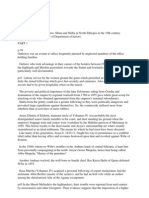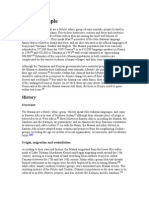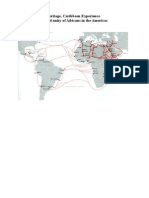History: of Kenya
History: of Kenya
Uploaded by
Hailemariam MekonenCopyright:
Available Formats
History: of Kenya
History: of Kenya
Uploaded by
Hailemariam MekonenOriginal Title
Copyright
Available Formats
Share this document
Did you find this document useful?
Is this content inappropriate?
Copyright:
Available Formats
History: of Kenya
History: of Kenya
Uploaded by
Hailemariam MekonenCopyright:
Available Formats
History
of Kenya
It is known that human history in Kenya dates back millions of years, because it is there
that some of the earliest fossilized remains of hominids have been discovered. Among
the best-known finds are those by anthropologist Richard Leakey and others in
the Koobi Fora area along the shore of Lake Rudolf that have included portions
of Australopithecus boisei and Homo habilis skeletons. The following discussion,
however, covers the history of Kenya only from the 18th century. For coverage of earlier
periods and for a treatment of the country in its regional context, see Eastern Africa.
The 18th and 19th centuries
Maasai and Kikuyu
The Maasai moved into what is now central Kenya from an area north of Lake Rudolf
sometime in the mid-18th century. Their southward advance was checked about 1830 by
the Hehe people from what is now Tanzania, but their raiding parties continued to range
widely and even reached the coast south of Mombasa in 1859. The
Maasai moran (“warrior”) prepared for war under the spiritual direction of
the laibon (“medicine man”). Although not particularly numerous, the Maasai were able
to dominate a considerable region because the Bantu-speaking inhabitants offered little
effective resistance to their raids. The Nandi, who inhabited the escarpment to the west
of the Maasai, were equally warlike and were relatively undisturbed by their predatory
neighbours. Another group, the Taveta, took refuge in the forest on the eastern slopes of
Mount Kilimanjaro, while the Taita, who were farther east, used the natural strongholds
provided by their mountainous homeland to resist the Maasai raiders.
The Kikuyu, who were far more numerous than the Maasai, also looked to the
mountains and forests for protection against Maasai war parties. The Kikuyu had
expanded northward, westward, and southward from their territory in the Fort Hall area
of present-day Central province, where they cleared the forests to provide themselves
with agricultural land. Toward the end of the 19th century, however, they had reached
the limits imposed by the presence of the Maasai to the north and south and by the
upper slopes of the Aberdare Range to the west.
Famine and smallpox in the 1890s compelled the Kikuyu to vacate much of the land in
what is now Kiambu district (in Central province) as they withdrew northward. The
Maasai too were passing through a difficult period. An outbreak of disease, either
pleuropneumonia or rinderpest, attacked their cattle in 1883; further infestations in
1889–90 continued to decimate their herds, while the Maasai themselves were
overwhelmed by epidemics of smallpox. Simultaneously, the death of Mbatian, their
great laibon, split the group into warring factions, and it was some time before his
younger son, Lenana, was able to restore order. Power was never revived, however,
because their problems coincided with the arrival of European traders and
administrators who eventually gained control of the region.
You might also like
- Dr. Patrick J. Bryant Pharm.D. FSCIP, Dr. Heather A. Pace Pharm.D. - The Pharmacist's Guide To Evidence-Based Medicine For Clinical Decision Making-ASHP (2008) PDFDocument209 pagesDr. Patrick J. Bryant Pharm.D. FSCIP, Dr. Heather A. Pace Pharm.D. - The Pharmacist's Guide To Evidence-Based Medicine For Clinical Decision Making-ASHP (2008) PDFRaju Niraula100% (1)
- Conversion To Christianity Among The NagasDocument44 pagesConversion To Christianity Among The NagasRaiot Webzine100% (4)
- EBOLADocument4 pagesEBOLAwawa3385No ratings yet
- In Darkest Africa (9) A Masai ArmyDocument7 pagesIn Darkest Africa (9) A Masai ArmySpanishfury100% (1)
- History of Kenya EditDocument7 pagesHistory of Kenya EditKiiru EdgarNo ratings yet
- Gusii migrationAADocument6 pagesGusii migrationAAHeavy DutyNo ratings yet
- Reading CH 18 States and Societies of Sub-Saharan AfricaDocument22 pagesReading CH 18 States and Societies of Sub-Saharan AfricaSophie ZhaoNo ratings yet
- Mwanyagetinge Heritage Council Gova KisiiDocument16 pagesMwanyagetinge Heritage Council Gova KisiiHeavy DutyNo ratings yet
- Nongqawuse For Steve BikoDocument2 pagesNongqawuse For Steve BikoBiko LegacyNo ratings yet
- History AzDocument8 pagesHistory AzHafiza GuliyevaNo ratings yet
- 1 TarayiaDocument40 pages1 TarayiaLaiza May LampadNo ratings yet
- Nyamwezi People - WikipediaDocument48 pagesNyamwezi People - WikipediaashirafprobalikitendeNo ratings yet
- The Rhodesian HistoryDocument37 pagesThe Rhodesian HistoryNokuthula MoyoNo ratings yet
- O Level History SeminarDocument40 pagesO Level History Seminarmostoftiktok80No ratings yet
- F1 - The People of Kenya Upto The 19TH CenturyDocument6 pagesF1 - The People of Kenya Upto The 19TH Centurydev100% (1)
- Between1000-1300 ADDocument80 pagesBetween1000-1300 ADzakNo ratings yet
- Shift ADocument24 pagesShift AworwarNo ratings yet
- Band, Tribe, Chiefdom, States, Nation, Stateless NationDocument7 pagesBand, Tribe, Chiefdom, States, Nation, Stateless NationMthw MathewNo ratings yet
- History of Mizoram - WikipediaDocument12 pagesHistory of Mizoram - WikipediaK Lalremtluangi 066No ratings yet
- Hungary 5 History CultureDocument25 pagesHungary 5 History CultureArhip Cojoc100% (1)
- Maasai PeopleDocument11 pagesMaasai PeopleShreya Tiwari100% (1)
- Khoikhoi PeopleDocument3 pagesKhoikhoi PeopleAlberto CuambeNo ratings yet
- First GermanbDocument2 pagesFirst Germanbapi-308074527No ratings yet
- Hausa Kingdoms - WikipediaDocument19 pagesHausa Kingdoms - WikipediaAdeshina MoyoadeNo ratings yet
- In Darkest Africa (7) Nyasaland 1887 1895Document8 pagesIn Darkest Africa (7) Nyasaland 1887 1895Spanishfury100% (2)
- 2.HistoryDocument9 pages2.Historybwalyaa1984No ratings yet
- O Level History SeminarDocument40 pagesO Level History Seminartyrisjordan983No ratings yet
- Apush Chapter 1 Chapter TermsDocument11 pagesApush Chapter 1 Chapter Termsaca2811No ratings yet
- 4. the Peoples of Kenya Up to the 19th CenturyDocument9 pages4. the Peoples of Kenya Up to the 19th Centuryphyliskamau022No ratings yet
- Namibia'S People: Although Namibia Is The SecondDocument4 pagesNamibia'S People: Although Namibia Is The SecondEd Chikuni100% (1)
- Battle in Africa 1879-1914Document50 pagesBattle in Africa 1879-1914Franck Yeghicheyan100% (3)
- Kami Export - Quentin Koch - Transformation of A Continent ReadingDocument3 pagesKami Export - Quentin Koch - Transformation of A Continent Readingquentin.kochNo ratings yet
- Csec Theme A Section 1Document25 pagesCsec Theme A Section 1Dawnuh100% (4)
- Bantu Migration - Ancient History Encyclopedia PDFDocument10 pagesBantu Migration - Ancient History Encyclopedia PDFEmelda MimieNo ratings yet
- History of GhanaDocument8 pagesHistory of GhanaghanadatdotcomNo ratings yet
- Kalumbete NotesDocument42 pagesKalumbete NotesAlbert MoshiNo ratings yet
- Fort Leavenworth History (1827-1983)Document268 pagesFort Leavenworth History (1827-1983)CAP History LibraryNo ratings yet
- Eastern and Western Europe TribesDocument11 pagesEastern and Western Europe TribesBrian MendozaNo ratings yet
- South African HistoryDocument100 pagesSouth African Historyobedimark10No ratings yet
- History of The Indigenous People in The CaribbeanDocument20 pagesHistory of The Indigenous People in The CaribbeanLian E. NewalloNo ratings yet
- S.2 History S.A Home - Week 6Document6 pagesS.2 History S.A Home - Week 6kakembo hakimNo ratings yet
- Anql 3Document5 pagesAnql 3gnqckx4yxsNo ratings yet
- Expanding Frontiers and TradeDocument2 pagesExpanding Frontiers and TradeCiprian RadeanuNo ratings yet
- Military History of Rhodesia ZimbabweDocument75 pagesMilitary History of Rhodesia Zimbabwemika2k01100% (4)
- The Great Plains: Students' Names: Lucchesi FlorenciaDocument4 pagesThe Great Plains: Students' Names: Lucchesi FlorenciaMartina CantosNo ratings yet
- Eng6691 7935Document4 pagesEng6691 7935Abdul BasitNo ratings yet
- 02 SW 2Document10 pages02 SW 2Lelia TatuNo ratings yet
- The Origin & Cultural Unity of Africans in The AmericasDocument12 pagesThe Origin & Cultural Unity of Africans in The AmericasKofi Black100% (1)
- 1SPLX9JkQ7Lo2hUdhOmgGjWISawDocument3 pages1SPLX9JkQ7Lo2hUdhOmgGjWISawSabah FETAHNo ratings yet
- Harzig and Hoerder 2009 CH 2.5-2.9Document16 pagesHarzig and Hoerder 2009 CH 2.5-2.9Mia KisicNo ratings yet
- The Cambridge Medieval History - Book XV: The Eastern Roman Empire from Isaac I to AndronicusFrom EverandThe Cambridge Medieval History - Book XV: The Eastern Roman Empire from Isaac I to AndronicusNo ratings yet
- A Brief History of Fort Leavenworth 1827-1983Document46 pagesA Brief History of Fort Leavenworth 1827-1983Paulo Da Silva MedeirosNo ratings yet
- Austronesians in East AfricaDocument12 pagesAustronesians in East AfricaMaximillian Heartwood100% (2)
- The Decolonization of Ghana and The Influence of Kwame NkrumahDocument94 pagesThe Decolonization of Ghana and The Influence of Kwame NkrumahJEAN-MALIK EDWARDSNo ratings yet
- Great Zimbabwe University 2017 Pre ColonDocument97 pagesGreat Zimbabwe University 2017 Pre ColonNedik GadeNo ratings yet
- Bantu MigrationsDocument2 pagesBantu Migrationskinneyjeffrey100% (1)
- 87 Animal Husbandry in Gram Panchayat PDFDocument72 pages87 Animal Husbandry in Gram Panchayat PDFKrishnaKishoreNo ratings yet
- (MT 56) Histo - The NucleusDocument4 pages(MT 56) Histo - The NucleusLiana JeonNo ratings yet
- GP Informational BriefDocument52 pagesGP Informational BriefDaniel Fisher100% (1)
- Drug ToxicityDocument7 pagesDrug ToxicityKelly ClemonsNo ratings yet
- Brief CommunicationDocument13 pagesBrief CommunicationsantovazNo ratings yet
- Kindred TortsDocument51 pagesKindred TortsJa CinthNo ratings yet
- 5607TNCC-Abdominal TraumaDocument65 pages5607TNCC-Abdominal Traumabagus100% (1)
- 1.3 Classification, Structure and Function of TissuesDocument15 pages1.3 Classification, Structure and Function of TissuesreddyapdscNo ratings yet
- Annual Report 2010Document72 pagesAnnual Report 2010Yan-Lin Jubi LeeNo ratings yet
- English Syllabus For IBPS ExamsDocument17 pagesEnglish Syllabus For IBPS ExamsKavi PriyaNo ratings yet
- Unlocking The Prediction of Preeclampsia, A Widespread, Life-Threatening Pregnancy ComplicationDocument5 pagesUnlocking The Prediction of Preeclampsia, A Widespread, Life-Threatening Pregnancy ComplicationImam SantosoNo ratings yet
- Physiology of DigestionDocument15 pagesPhysiology of Digestionreema amynNo ratings yet
- Pae PediatriaDocument25 pagesPae PediatriaLuna Jenny Capia ZegarraNo ratings yet
- Ent DVTDocument38 pagesEnt DVTlakhan rathoreNo ratings yet
- Sample Test For MAPEHDocument18 pagesSample Test For MAPEHrebz100% (2)
- Strep and EnterococciDocument64 pagesStrep and EnterococciJamil Muqtadir BhattiNo ratings yet
- How Weight Loss Can Transform Your LifeDocument1 pageHow Weight Loss Can Transform Your Lifeanbrosewakaba2002100% (1)
- An Analysis of Social Media RumorDocument22 pagesAn Analysis of Social Media RumorPrithula Prosun PujaNo ratings yet
- Female Sexual Dysfunction: Reference: Tog Article 2021Document14 pagesFemale Sexual Dysfunction: Reference: Tog Article 2021Rania AHNo ratings yet
- Liver Function TestDocument50 pagesLiver Function TestJhannNo ratings yet
- Who Ace-IqDocument16 pagesWho Ace-IqVeeNo ratings yet
- Ruhs CV April 2024Document9 pagesRuhs CV April 2024api-258655506No ratings yet
- Let's Learn English by Nouman TariqDocument256 pagesLet's Learn English by Nouman TariqMubeen ParwaizNo ratings yet
- Nursing Care Plan For Gunshot Wound To The Head: Assessment Diagnosis Planning Intervention Rationale EvaluationDocument13 pagesNursing Care Plan For Gunshot Wound To The Head: Assessment Diagnosis Planning Intervention Rationale EvaluationWeji ShNo ratings yet
- Walls Emergency Airway ManagementDocument28 pagesWalls Emergency Airway ManagementArun A MohanNo ratings yet
- CHN ExamDocument30 pagesCHN ExamKhei Laqui SN100% (3)
- Effect of Clozapine On Human Serum Prolactin Levels: Am J Psychiatry 136:12, December /979Document6 pagesEffect of Clozapine On Human Serum Prolactin Levels: Am J Psychiatry 136:12, December /979buddybbuddyNo ratings yet
- Sexually Transmitted DiseasesDocument30 pagesSexually Transmitted Diseasesmohd ameerNo ratings yet

























































































